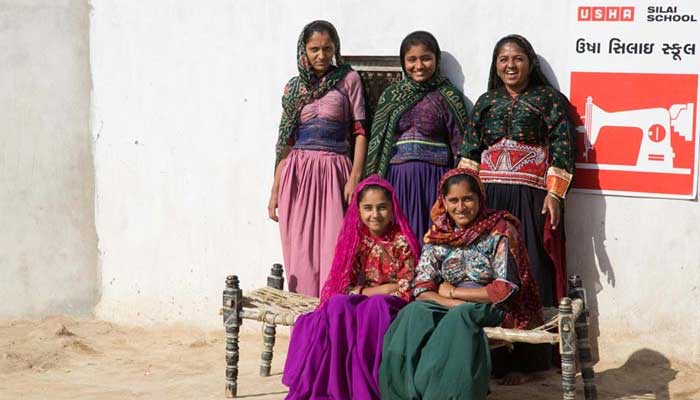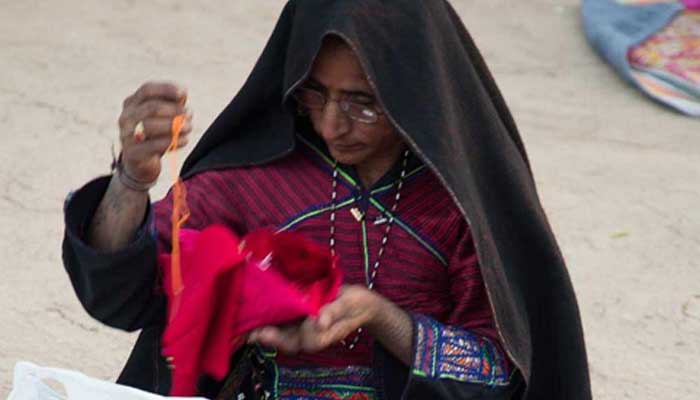- Home/
- In Nilgiris, Usha Silai School Is Preserving Heritage And Empowering Women Through Toda Embroidery
In Nilgiris, Usha Silai School Is Preserving Heritage And Empowering Women Through Toda Embroidery

From Khneng embroidery in Meghalaya to Warli Art in Dadra and Nagar Haveli, the USHA Silai School programme isn't just upskilling women by teaching them how to stitch and sew, it is also incorporating local art and heritage into the sewing programme to keep alive old traditions that were in danger of dying out. One such art form is Toda embroidery.
The women of the Toda tribe practice an ancient form of embroidery which is deeply intertwined with their culture and heritage. This embroidery reflects their unique way of life, beliefs, and artistic expression. Toda embroidery is renowned for its exquisite beauty and intricate patterns.
Also Read: Reviving Meghalaya's Khneng Embroidery And Empowering Women, One Stitch At A Time
There are 12 Toda families in the small village of Mullimund in Ooty district. One of them is Kavitha's family. The Toda community is a pastoral community and their specific style of embroidery has been practised for around 3,500 years. It acquired the Geographical Indication (GI) tag in 2013. The embroidery is an essential part of Toda culture, passed down through generations, symbolising the tribe's social and cultural identity.
Kavitha shared that she learned Toda embroidery from our parents.
They taught us how to practise this art form. We used to practise this embroidery daily.
Toda embroidery involves a meticulous and time-consuming technique. With a plain fabric as the base, designs are created using a process known as stitching or binding. The patterns are primarily geometrical and linear, with rhombuses, squares, and rectangles being common shapes. The embroidery is characterised by its use of a distinctive stitch, known as the 'blanket stitch' which creates a raised effect and gives the designs a three-dimensional appearance.
It was in October 2012 that Usha International, in collaboration with Keystone Foundation, conducted a seven-day residential training, which Kavitha was a part of. The training helped Kavitha improve her sewing skills, and she got a machine and a certificate once she completed the programme. A decade later, Kavitha is now not only making products but is also helping women from the community earn a livelihood.
Also Read: With Usha Silai School's Support, Women From The Northeast Make It To The East India Fashion Week
Vinod Kumar, Coordinator, Keystone Foundation said,
Since 2012, we have been working with Usha to provide training to the Toda tribes in the Nilgiris district. 500 out of 1,500 members of this tribe are practising Toda embroidery.
Sharing the result of her training, Kavitha said,
After I was trained at the Usha Silai School, I trained nearly 10 women. Now they are practising Toda embroidery and other stitching work. Currently, around 20 women are practising Toda embroidery in our village.
The motifs and designs in Toda embroidery are inspired by nature, daily life, and the Toda tribe's beliefs and rituals. The designs often depict scenes from the tribe's environment, such as animals, flowers, hills, and their pastoral life. Additionally, sacred symbols, representing their religious beliefs and ceremonies, are prevalent in Toda embroidery. Each motif carries a unique meaning, making this craft a form of storytelling and cultural preservation for the Toda community.
Kavitha added,
We never copy the patterns and designs of others. All the designs are created by us, from our imagination.
Through the Usha Silai School, tribal women gain the necessary skills to create marketable products. They can monetise their Toda embroidery skills by making garments, accessories, and home decor items, giving themselves a sustainable source of income and economic independence. Learning these skills boosts the confidence and self-esteem of tribal women, making them self-reliant and financially capable. By becoming skilled artisans, they break traditional gender norms and take control of their lives and futures.
Sharing the workflow, from buying raw materials to selling the final product, Kavitha said,
We buy the cloth and other raw materials for the embroidery from a dedicated shop in Ooty. And we buy other materials like needles and threads from other shops. We make purses and cell phone covers, pouches, masks and coats. We sell these items in Ooty at a shop given to us by the government.
Vadivelan Perumal, Regional Manager - South, Usha Silai Schools said,
In the entire southern region we have around 7,000 Usha Silai Schools. In Tamil Nadu, we have 1,566 Usha Silai Schools. In the Nilgiris, we have trained 94 women, who belong to different tribal groups.
The Usha Silai School initiative is playing a vital role in empowering tribal women across India. By integrating traditional skills into the curriculum, Usha Silai Schools are not only preserving the rich cultural heritage of the country but are also providing economic opportunities and empowering women to improve their lives and the lives of their communities.
Also Read: USHA And Northern Railways Join Hands To Make Jaipur Women Financially Independent
also read
Related Stories
More- Written by Team NDTV | Friday December 12, 2025
USHAs Silai School Programme empowers women across India by turning sewing into independence. Women become trainers and leaders, transforming their lives and communities through skills, confidence, and income
- Written by Team NDTV | Thursday December 11, 2025
USHA Silai School is empowering women across India by turning sewing skills into leadership and income. Women like Lalita, Yashira, and Pushpakala have become mentors, reviving traditions and building stronger communities. Their stories show how one skill can weave a brighter future.
- Written by Team NDTV | Wednesday December 10, 2025
From homemaker to celebrated teacher, Lakhi Debnath transformed her life via Usha Silai School, funding her daughters' education and buying land through tailoring
- Written by Team NDTV | Tuesday December 09, 2025
In Takkar Birpur village, Jammu and Kashmir, Kanta Devi escaped domestic violence and poverty through the Usha Silai School's tailoring training. Earning ₹10,00020,000 monthly, she now teaches women in border areas while inspiring her daughter Tanya to dream of a bourtique
Adopt a Silai School
About the Initiative

Kushalta Ke Kadam, an initiative by USHA Silai School and NDTV has entered its eighth season. The aim is to empower more women across rural India by teaching them sewing skills and helping them open new doors of opportunities for themselves. The initiative encourages rural women to become financially independent and entrepreneurs by taking up sewing and training others in their respective communities.
Since 2011, the USHA Silai School initiative has trained more than 12 lakh rural women through over 33,000 Silai schools, spanning over 20,751 villages across India.
The women earn Rs. 4,000 – 5,000 per month on an average, with the highest recorded monthly earning being Rs. 84,000 in a month. This earning works as a catalyst towards building their self-confidence, reducing gender inequities, and raising their stature within their families and in society at large.
In Pics

Rebari girls grow up learning traditional embroidery, which along with their new found sewing skills developed at Usha Silai Schools, is helping them earn a living.

Usha Silai School has empowered many rural women to support their family and send their children to school.

The Usha Silai School, established in a small nondescript village that goes by the name of Kottai, is helping empower people from varied communities.

The all-inclusive Usha Silai School Programme covers the entire nation from hamlets tucked between hills to villages cast by the sea.

Vegetables farmers from the Mizoram hills earn very little given the topography of the area. Usha Silai Schools have played an important part in this region by skilling women to financially contribute towards their households.

Usha Silai School learner Lucy has trained seven other women in her community, helping them to become financially independent.

Women like Kaviben from the nomadic Rebari community are finally laying down their roots as they begin to gain financial independence and thereby stability through Usha Silai School.

Usha Silai School, located in the Gujarat's Bhuj village, is enabling rural women to earn as much as Rs. 2,500-4,000 each month.

Usha Silai School, in association with a Gujarat based NGO called Kala Raksha, is trying to bring about a Silai revolution in Bhuj.

Besides training other women from their community, many Usha Silai School learners have become entrepreneurs in their own right.

With sewing becoming easily accessible and lucrative, the silai schools are also helping revive traditional motifs and designs.






